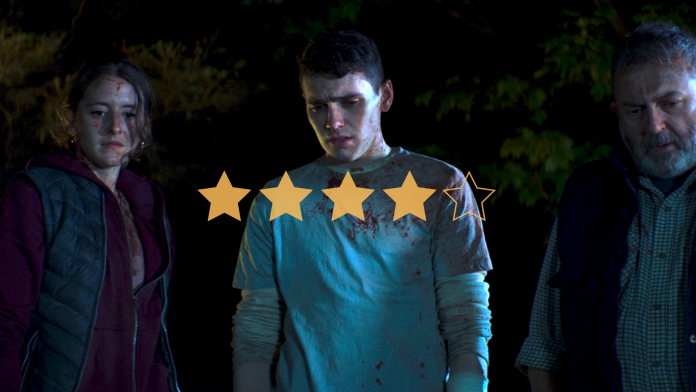★★★★✰
Imagine Normal People, but if it was set in Northern Ireland instead of Dublin, there was no Marianne, and Connell was vampirised by a rampaging folkloric bloodsucking monster. Sound good? Welcome to Boys From County Hell.
Chris Baugh’s new Irish horror comedy centres around a small town terrorised by the original grandaddy of vampires, the mythical Irish Abhartach. This ancient blood drinking chieftain is one of the neamh-mhairbh, the Irish undead, and is said (at least by the wily tourism-inclined locals) to have inspired Bram Stoker in his writing of Dracula. Little do they know that the one tourist attraction keeping the backwater town afloat, a large cairn of stones over the monster’s grave, is also keeping Abhartach down. He’s been slumbering there peacefully for years, until a new bypass is commissioned that runs right over his resting place.
Working the bypass construction job is a young rural burnout called Eugene (Jack Rowan), his emotionally stunted father Francie (Nigel O’Neill), and a motley crew of workers including Derry Girls’ Louisa Harland. They balance vampire hunting with a lively balance of drinking, fighting, and Gaelic football. When Abhartach is accidentally liberated by the crew, they are all that stands between him and draining the town dry. And because Boys from County Hell is that rare species of horror film that features characters who are legitimately well developed and likeable, we actually care when the newly unleashed creature emerges to chow down.
The Abhartach joins a long list of Irish folk figures adapted for horror films, from the infamous leprechaun and the genuinely scary fairies of Corin Hardy’s The Hallow to the direct-to-Syfy Channel schlock like Scream of the Banshee (produced by Sharknado’s own Anthony Ferrante). The film also references real life folkloric tendencies in Ireland, with the roadworkers hesitance to knock over Abhartach’s grave mimicking the still popular reluctance to knock down a ‘fairy tree’ during the construction of motorways.
Abhartach stalks the town in classic vampish bad-guy style, but with several unique additions to the subgenre. In one of the most unnerving aspects of the film, his very presence causes rivers of his victims’ blood to gush spontaneously from their orifices towards the succubus. He is also too hardy to be deterred by traditional vampire slaying methods, and the vampirism is spread through the stones that covered his grave—not his bite.
Despite its original subject matter though, there isn’t much stylistically in Boys from County Hell that differentiates it from the ordinary horror flick. It reads like a pretty run-of-the-mill scary movie with a band of characters reacting to an unexpected threat. But everything it does it does well, from the epic orchestral score to the top notch practical effects, tight action sequences, and stellar performances.
The characters are easy to love, the writing is solid, and the chemistry between the cast is natural; although the horror comes off substantially better than the comedy, which isn’t always perfectly timed. The humour occasionally sticks its foot in during moments on the brink of becoming a genuinely touching or blood-chilling moment. But it still has its comedic high-points, especially for any Irish people like myself who has thoroughly enjoyed the harmless native pastime of lying through your teeth to tourists.
Horror films and folklore sit so well alongside one another, and there’s far more to Irish traditional stories than faeries and leprechauns. In fact, horror and folklore have lots in common; they each locate the supernatural in a secular world, they both satisfy the very human need to believe in something more extraordinary than the everyday, and they both confront that most frightening thing of all—the unknown.
In pre-literate Ireland, folk tales supplied monsters to answer the questions that ordinary people couldn’t: changelings explained child mortality, fairies were blamed for a bad harvest, and witches (cailleach) could be held accountable when your milk wouldn’t churn into butter. The unknown haunts the life of Eugene too, who struggles to envision a bright future for himself in an all-too-familiar Irish landscape of rural decline, when every young person is emigrating to either Australia or Canada. It’s a treat to see home grown horror putting both traditional Irish folklore and traditional Irish social problems centre stage, enough to make any Irish viewers feel proud and leave any audience thoroughly entertained.
The Verdict
It’s a difficult line to walk, but Boys from County Hell manages to be both properly funny and truly frightening in turn. Irish horror-comedy seems to be on a roll after Extra Ordinary and shorts like Something Doesn’t Feel Right, and Boys From County Hell is a welcome addition to the family. It’s not perfect, but it’s tense, it’s funny, and it’s a bloody good time.
Boys From County Hell is in cinemas now.
Words by Eli Dolliver
Support The Indiependent
We’re trying to raise £200 a month to help cover our operational costs. This includes our ‘Writer of the Month’ awards, where we recognise the amazing work produced by our contributor team. If you’ve enjoyed reading our site, we’d really appreciate it if you could donate to The Indiependent. Whether you can give £1 or £10, you’d be making a huge difference to our small team.
